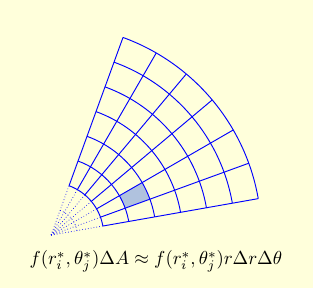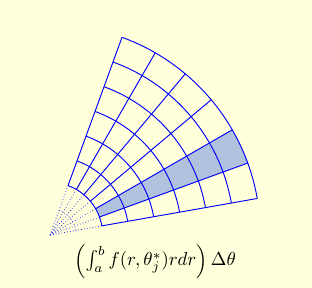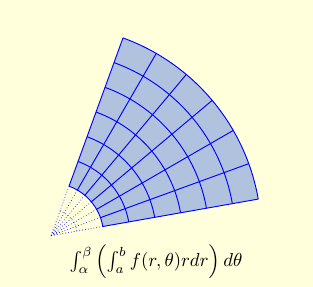
Home
Integration by Parts
Integration by PartsExamples
Integration by Parts with a definite integral
Going in Circles
Tricks of the Trade
Integrals of Trig Functions
Antiderivatives of Basic Trigonometric FunctionsProduct of Sines and Cosines (mixed even and odd powers or only odd powers)
Product of Sines and Cosines (only even powers)
Product of Secants and Tangents
Other Cases
Trig Substitutions
How Trig Substitution WorksSummary of trig substitution options
Examples
Completing the Square
Partial Fractions
Introduction to Partial FractionsLinear Factors
Irreducible Quadratic Factors
Improper Rational Functions and Long Division
Summary
Strategies of Integration
SubstitutionIntegration by Parts
Trig Integrals
Trig Substitutions
Partial Fractions
Improper Integrals
Type 1 - Improper Integrals with Infinite Intervals of IntegrationType 2 - Improper Integrals with Discontinuous Integrands
Comparison Tests for Convergence
Modeling with Differential Equations
IntroductionSeparable Equations
A Second Order Problem
Euler's Method and Direction Fields
Euler's Method (follow your nose)Direction Fields
Euler's method revisited
Separable Equations
The Simplest Differential EquationsSeparable differential equations
Mixing and Dilution
Models of Growth
Exponential Growth and DecayThe Zombie Apocalypse (Logistic Growth)
Linear Equations
Linear ODEs: Working an ExampleThe Solution in General
Saving for Retirement
Parametrized Curves
Three kinds of functions, three kinds of curvesThe Cycloid
Visualizing Parametrized Curves
Tracing Circles and Ellipses
Lissajous Figures
Calculus with Parametrized Curves
Video: Slope and AreaVideo: Arclength and Surface Area
Summary and Simplifications
Higher Derivatives
Polar Coordinates
Definitions of Polar CoordinatesGraphing polar functions
Video: Computing Slopes of Tangent Lines
Areas and Lengths of Polar Curves
Area Inside a Polar CurveArea Between Polar Curves
Arc Length of Polar Curves
Conic sections
Slicing a ConeEllipses
Hyperbolas
Parabolas and Directrices
Shifting the Center by Completing the Square
Conic Sections in Polar Coordinates
Foci and DirectricesVisualizing Eccentricity
Astronomy and Equations in Polar Coordinates
Infinite Sequences
Approximate Versus Exact AnswersExamples of Infinite Sequences
Limit Laws for Sequences
Theorems for and Examples of Computing Limits of Sequences
Monotonic Covergence
Infinite Series
IntroductionGeometric Series
Limit Laws for Series
Test for Divergence and Other Theorems
Telescoping Sums
Integral Test
Preview of Coming AttractionsThe Integral Test
Estimates for the Value of the Series
Comparison Tests
The Basic Comparison TestThe Limit Comparison Test
Convergence of Series with Negative Terms
Introduction, Alternating Series,and the AS TestAbsolute Convergence
Rearrangements
The Ratio and Root Tests
The Ratio TestThe Root Test
Examples
Strategies for testing Series
Strategy to Test Series and a Review of TestsExamples, Part 1
Examples, Part 2
Power Series
Radius and Interval of ConvergenceFinding the Interval of Convergence
Power Series Centered at $x=a$
Representing Functions as Power Series
Functions as Power SeriesDerivatives and Integrals of Power Series
Applications and Examples
Taylor and Maclaurin Series
The Formula for Taylor SeriesTaylor Series for Common Functions
Adding, Multiplying, and Dividing Power Series
Miscellaneous Useful Facts
Applications of Taylor Polynomials
Taylor PolynomialsWhen Functions Are Equal to Their Taylor Series
When a Function Does Not Equal Its Taylor Series
Other Uses of Taylor Polynomials
Functions of 2 and 3 variables
Functions of several variablesLimits and continuity
Partial Derivatives
One variable at a time (yet again)Definitions and Examples
An Example from DNA
Geometry of partial derivatives
Higher Derivatives
Differentials and Taylor Expansions
Differentiability and the Chain Rule
DifferentiabilityThe First Case of the Chain Rule
Chain Rule, General Case
Video: Worked problems
Multiple Integrals
General Setup and Review of 1D IntegralsWhat is a Double Integral?
Volumes as Double Integrals
Iterated Integrals over Rectangles
How To Compute Iterated IntegralsExamples of Iterated Integrals
Fubini's Theorem
Summary and an Important Example
Double Integrals over General Regions
Type I and Type II regionsExamples 1-4
Examples 5-7
Swapping the Order of Integration
Area and Volume Revisited
Double integrals in polar coordinates
dA = r dr (d theta)Examples
Multiple integrals in physics
Double integrals in physicsTriple integrals in physics
Integrals in Probability and Statistics
Single integrals in probabilityDouble integrals in probability
Change of Variables
Review: Change of variables in 1 dimensionMappings in 2 dimensions
Jacobians
Examples
Bonus: Cylindrical and spherical coordinates
Conceptually, computing double integrals in polar coordinates is the same as in rectangular coordinates. After all, the idea of an integral doesn't depend on the coordinate system. If $R$ is a region in the plane and $f(x,y)$ is a function, then $\iint_R f(x,y) dA$ is what we get when we
- Chop $R$ into a bunch of small pieces.
- Compute $f(x^*,y^*)\Delta A$ for each piece, where $\Delta A$ is the area of the piece.
- Add up the contributions of the pieces, and
- Take a limit as we chop $R$ into smaller and smaller pieces.
The differences when working with polar coordinates are explained in the following video:
| When working with rectangular coordinates, our pieces are boxes of width $\Delta x$, height $\Delta y$, and area $\Delta A = \Delta x \Delta y$. When working with polar coordinates, our pieces are polar rectangles. These are regions of the form $\theta \in [\alpha, \beta]$, $r \in [a,b].$ The approximate contribution of a single box to our integral is $f(r_i^*,\theta_j^*) \Delta A$, where $\Delta A$ is the area of the box. [Here we are thinking of $f$ as a function of $r$ and $\theta$. If $f$ is a function of $x$ and $y$, then strictly speaking we should write $f(r \cos(\theta), r\sin(\theta))$ instead of $f(r,\theta)$.] |
|
So what is the area of a polar rectangle? The polar rectangle is the difference of two pie wedges, one with radius $b$ and one with radius $a$, and so has area \begin{eqnarray*} \Delta A & = & \frac{b^2}{2}(\beta-\alpha) - \frac{a^2}{2}(\beta - \alpha) \\ & = & \frac{b^2-a^2}{2}(\beta-\alpha) \\ & = & \frac{a+b}{2} (b-a)(\beta - \alpha) \\ & = & r^* \Delta r \Delta \theta, \end{eqnarray*} where $r^*=\frac{a+b}{2}$ is the average value of $r$, $\Delta r = b-a$ is the change in $r$ and $\Delta \theta = \beta-\alpha$ is the change in $\theta$.
Another way to understand this is to look at the shape of a small polar rectangle, like the shaded box in the figure above. This is almost a rectangular, only rotated and with slightly curved sides. One side has length $\Delta r$. The other had length approximately $r \Delta \theta$. So the whole rectangle has approximate area $r \Delta r \Delta \theta$.
| Now we organize our boxes. Since the contribution of each box is approximately $f(r_i^*,\theta_j^*) r_i^* \Delta r \Delta \theta$, the contribution of the boxes in the same thin pie wedge is approximately $\left (\int_a^b f(r,\theta_j^*) r dr \right ) \Delta \theta$. |
|
| Finally we put all the pie wedges together, to get a total of $\int_{\alpha}^\beta \left ( \int_a^b f(r,\theta) r dr \right ) d\theta$. |
|
|
The infinitestimal area in rectangular coordinates is $dA = dx\, dy$. The
infinitesimal area in polar coordinates is $$dA = r \, dr \, d\theta.$$
Don't forget the factor of $r$!! Double integrals in polar coordinates become iterated integrals $$ \iint f(x,y) dA \ = \ \int\int f(r\cos(\theta), r\sin(\theta)) r \, dr \, d\theta \ = \ \int \int f(r\cos(\theta), r\sin(\theta)) r\, d\theta\,dr,$$ with appropriate limits of integration. |


